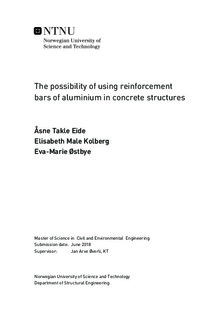The possibility of using reinforcement bars of aluminium in concrete structures
Master thesis
Permanent lenke
http://hdl.handle.net/11250/2562319Utgivelsesdato
2018Metadata
Vis full innførselSamlinger
Sammendrag
In this study, the possibility of using aluminium as reinforcement in concrete structures is investigated, with use of a low pH concrete. The thesis is assigned by NTNU, and is a part of the science project DARE2C, a project that SINTEF is researching together with NTNU and several other companies from the construction and innovation industry. It is believed that using aluminium as reinforcement will have a favourable impact to the concrete durability, and contribute to more maintenance-free constructions.
A laboratory study is performed, which includes production and testing of six reinforced concrete beams, where the beams are reinforced differently with a variation of material and cross-sectional shapes. Five of the beams are reinforced with alloyed aluminium, while the last beam is reinforced with steel reinforcement. The steel reinforcement is ribbed, while the aluminium reinforcement has smooth surface. The concrete prescription and the alloyed aluminium reinforcement are adjusted to chemically function together. The beam design is performed in accordance with the Eurocode, with some adjustments due to usage of aluminium reinforcement.
Calculations are performed prior to the laboratory testing. In connection with the beam production, cylinders were produced to verify the concrete properties. The tests from laboratory resulted in shear failure for the reference beam with steel reinforcement, while the remaining five beams with aluminium reinforcement obtained anchorage failure. The bond between the concrete and aluminium bars was poor due to the smooth surface of the reinforcement. Thus, the calculated values differed from the laboratory test results.
The deflections were larger in the laboratory than calculated for all beams. Control calculations performed after the laboratory testing for the steel reinforced beam, show that the deflection from the laboratory is valid. For the aluminium reinforced beams, the large deflections can be explained due to poor bond strength. Calculations of the actual bond strength are carried out for the steel reinforced beam and for one of the aluminium reinforced beam. The calculations show that the bond strength of the aluminium reinforced beam was lower than the given requirements, while it was higher for the steel reinforced beam.
